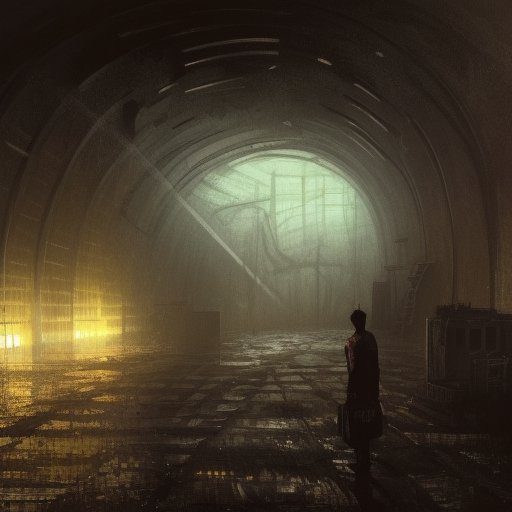
The nuclear fallout brought drastic changes to the weather in the underground tunnels. No longer the same as above ground, the climate in the tunnels is now full of extreme temperatures and hazardous conditions. Inhabitants must use advanced technology and methods to protect themselves from the harsh elements. Despite the risks, the weather also provides a chance for survivors to thrive and preserve their way of life. Through careful use of the changing climate, people can find a way to survive in this new world.
I. Introduction
The future of Earth is bleak. After a nuclear apocalypse, the surface of our planet is no longer inhabitable and life has been forced underground. Our once diverse climate has been reduced to a desolate wasteland of radioactive dust and ash. But what of the underground tunnels? How have the conditions changed down in the depths? This article aims to explore the new weather in the tunnels and how it affects the living conditions of those who remain. We will look at the effects of nuclear fallout on the weather, how it has changed in the tunnels and what technology is being used to help people survive. Finally, we will consider how the new weather conditions can be used to aid in self-preservation.
II. Nuclear Fallout and its Effects on Weather
The nuclear fallout has had a devastating impact on the weather. Dust and ash have blotted out the sun, creating a dark, oppressive and oppressive atmosphere. What once was a vibrant landscape of varying climates is now a desolate wasteland. The temperatures in the tunnels have dropped significantly, making the air cold and damp. The air is stale and stagnant, with no wind to stir it. The dust has also created an environment where it is difficult to breathe. These conditions have created a stark contrast to the warm, vibrant climates that once existed on the surface.

The drastic change in temperature and humidity has also caused a number of other environmental changes. Rainfall has become a rare occurrence, and the air is dry and arid. This has caused the flora and fauna of the tunnels to suffer, as plants and animals can no longer survive in such harsh conditions. The air has also become heavily polluted, with particles of dust, ash, and radiation being spread throughout the tunnels. This has caused a number of health problems for those still living in the tunnels.
The drastic change in the weather has caused the tunnels to become incredibly dangerous places. The lack of sunlight has caused the tunnels to become dark and dank, making them difficult to navigate. The winds in the tunnels have become incredibly strong, making it hard to move around and even harder to stay in one place. The extreme temperatures and humidity have also caused a number of other problems, such as mold, fungus, and bacteria.
These conditions have created an incredibly inhospitable environment, one that is not suitable for sustaining life. But despite the harsh conditions, life has been forced to adapt and survive in the tunnels. Those who remain in the tunnels must find ways to survive the weather, for the future of humanity depends on it.
III. How the Weather Changed in the Underground Tunnels
The nuclear fallout has drastically changed the weather in the underground tunnels. The air has become thick and humid, and the temperature has risen significantly. The once comfortable climate of the tunnels is now stuffy and uncomfortable. The air is stale and heavy, and the air quality has decreased significantly due to the radioactive dust and ash that now hangs in the air. The temperature has risen to an unbearable level, making it hard to stay cool or dry in the tunnels. As a result of the climate change, the underground tunnels now experience much more extreme weather. The heat and humidity can be oppressive, and the cold can be unbearable. The storms that arise from the combination of heat and humidity can be violent and dangerous. These storms cause a lot of destruction, making it difficult for those living in the tunnels to survive.
IV. Describing the New Weather in the Tunnels
The weather in the underground tunnels is drastically different from the surface. Gone are the temperate climates, replaced by a frigid cold. The air is still, devoid of any wind and the humidity is oppressive. The air is stale, and the temperature hovers around a constant, freezing point. Those who venture away from the main tunnels risk being struck down by a fierce snowstorm. The snowfall is dense and unrelenting, with temperatures dropping to unimaginable lows. In the depths of the tunnels, the snowfall is so thick that it is often impossible to see more than a few feet ahead. Despite the harsh conditions, some of the tunnels remain habitable, protected from the elements by a thick layer of ice. The lucky few who inhabit these tunnels have adapted to the cold and are able to survive in the extreme temperatures. However, those who venture beyond the safety of the tunnels are at the mercy of the elements.
V. How the Weather Affects Living Conditions in the Tunnels
The weather in the tunnels has changed drastically due to the nuclear fallout. The air is thick with radiation, making it difficult to breathe. The temperature has also dropped significantly, leaving inhabitants shivering in the cold. In addition, humidity levels have risen significantly, making it hard to stay dry. All of these conditions make life difficult for those living in the tunnels.

The radiation levels in the air make it difficult for people to stay healthy. Prolonged exposure to radiation can lead to a variety of illnesses, including cancer and other ailments. Furthermore, the cold temperatures make it hard to keep warm, leading to the risk of hypothermia and other cold-related illnesses. The high humidity levels cause mold and mildew to grow on the walls, leading to respiratory problems.
The effects of the weather on the tunnels are not only physical but also psychological. Living in such a harsh environment can be especially hard on the mental health of those inhabiting the tunnels. The lack of light, the cold temperatures, and the feeling of being trapped can all lead to feelings of depression and anxiety.
These conditions make it difficult for those living in the tunnels to stay safe. The radiation, the cold, and the humidity all make it hard to stay healthy and safe. Without proper protection, the inhabitants are at risk of exposure to the elements, which can lead to serious illness or even death. Without adequate shelter, it can be difficult to stay warm and dry, leading to further health risks.
VI. Technology That Helps People Survive the Weather
The oppressive atmosphere of the underground tunnels is no longer fit for human life. To survive, the inhabitants must use technology to maintain livable conditions. In order to regulate the temperature, ventilation systems and air purification systems have been implemented. Pressure valves, heat exchangers, and cooling systems are employed to balance the air pressure and keep the temperature within a habitable range.

Radiation-resistant materials are used to protect against the harmful radiation of the nuclear fallout. Protective wear made from advanced alloys, along with reinforced shelters and radiation-absorbing materials, help to reduce the effects of the fallout. Specialized radiation detectors and monitors are used to detect and measure the radiation levels, alerting inhabitants to seek shelter when necessary.
In some cases, inhabitants may have to venture into the radiation-filled tunnels to scavenge for resources. To help mitigate the risk of radiation poisoning, inhabitants must wear radiation-proof suits and equip themselves with radiation-blocking devices.
High-tech medical equipment helps to treat radiation poisoning and other illnesses caused by the harsh environment. Isolation chambers and medical-grade air filtration systems help to reduce the spread of contagious diseases.
To facilitate communication between the inhabitants and the outside world, a network of communication devices have been put in place. This network allows for the transmission of messages, data, and video.
The inhabitants of the underground tunnels have adapted to the new and dangerous environment. By using the latest technology, they are able to survive and thrive in the harsh conditions.
VII. How the Weather Aids in Self-Preservation
In the depths of the post-apocalyptic underground tunnels, the weather has become a powerful tool for self-preservation. With its ever-changing and unpredictable nature, it can be used to great effect in order to stay safe. The sudden temperature drops and gusts of wind can be used to mask one’s movements and avoid detection by hostile forces. The darkness of the tunnels can also be used as a shield against enemies, as the dim lighting makes it difficult to identify targets.

The humidity and moisture in the air can also be used to one’s advantage. In times of extreme cold, the moisture can help keep the body warm by trapping heat and creating a layer of insulation. On the other hand, during periods of extreme heat, the moisture in the air can help cool the body down and provide some respite from the heat.
The dust and debris that has settled in the tunnels can also be used for self-defense. By throwing dust and debris into the air, it can be used to obscure one’s vision, allowing for a quick escape. The dust and debris can also be used to create a smokescreen, hiding one’s movements from pursuers.
The weather in the tunnels has become an invaluable asset for self-preservation. With its ever-changing conditions, it can be used to one’s advantage to stay alive in a hostile environment. Through careful observation and use of the weather, it is possible to stay safe in the post-apocalyptic world.
VIII. Conclusion
After a nuclear apocalypse, the surface of the earth is no longer inhabitable, and life has been forced underground. The conditions in the tunnels are far from ideal, but the new weather conditions can be used to aid in self-preservation. Nuclear fallout has altered the weather and changed it in the tunnels, making it an extreme and hostile environment. People have had to use technology to survive the harsh conditions and find ways to live in the underground. Despite the bleak outlook, there remains hope that the human spirit can survive even in the most dire circumstances. As we move forward, it is important to remember that a better future is possible, no matter where we are.






